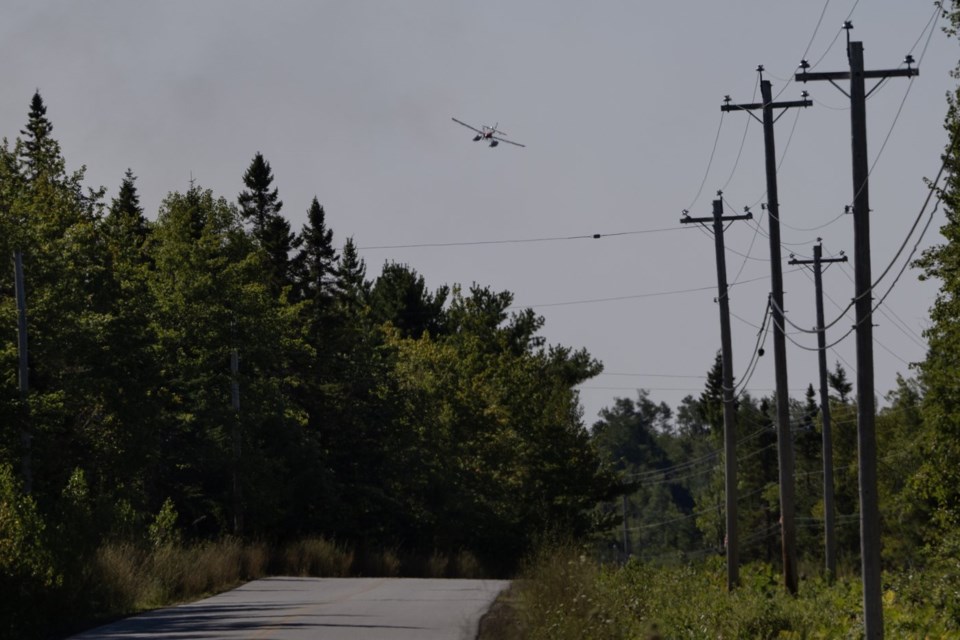HALIFAX — Extreme weather conditions over the weekend saw Nova Scotia’s largest fire more than double in size and damage homes in the Annapolis Valley for the first time since it broke out nearly two weeks ago.
Provincial officials confirmed Monday that the raging fire had damaged a number of homes in the area of West Dalhousie near Long Lake, although the exact number was unconfirmed.
“The Long Lake fire took a real turn over the weekend and it’s had devastating impacts,” Premier Tim Houston told reporters at a briefing in Halifax. “There has been a loss of homes and this is a crushing feeling.”
Burning since Aug. 13, the wildfire is classified as out of control and grew over the weekend from about 32 square kilometres in size to well over 77 square kilometres.
Firefighters battled high winds and dry conditions, both of which helped push the flames toward populated areas near Long Lake. Some rainfall was expected on Monday, although officials cautioned it likely wouldn’t be enough to make a difference.
Jim Rudderham, with the provincial Department of Natural Resources, said fire conditions were so bad on Sunday that firefighters had to be withdrawn from the area to ensure their safety.
“The day on Long Lake was a bad one,” said Rudderham. “The fire reacted to the weather conditions as we thought it would … and that fire stood up and ran away. Yesterday’s conditions were so extreme that we couldn’t touch it (the fire) with any resources, it was just too much.”
Officials said firefighters had returned to battle the blaze at daybreak on Monday and were constructing new fire breaks and trying to get as much water on the flames as they could.
Late Sunday, people living along a portion of Highway 10 in the West Dalhousie area were told to leave their homes. Earlier in the day residents on parts of Morse Road and Thorne Road were also told to flee. Before the weekend more than 100 homes had already been evacuated in the area.
The Municipality of the County of Annapolis confirmed Monday that 500 civic addresses were under evacuation orders, although not all of those are homes. Officials later confirmed that a total of 330 homes have now been evacuated in the area of the fire.
Evacuees have been directed to check in at a reception centre at the Nova Scotia Community College campus in Middleton, N.S. Dustin Enslow, the municipality’s deputy warden, told reporters that 138 people had registered so far at the shelter location.
The premier also announced the provincial government would be offering evacuees emergency financial help based on the number of days they were unable to stay at home.
Families who remain out of their homes between four and seven days would be eligible for $500 per adult and $200 per child. The amounts would be increased for people kept out of their homes for longer periods with the maximum amount of support reaching $3,000 per adult and $1,750 per minor.
“We want to ease a small portion of the financial stress that comes with the urgency of this situation,” Houston said.
Meanwhile, in Newfoundland and Labrador, a wildfire in Kingston, along the northeastern shore of Conception Bay, was burning on Monday at a “declined” level of intensity, officials said. However, the smoky blaze, which has burned over 100 square kilometres, is still classified as out of control.
A dozen firefighters from the province were dealing with hot spots with assistance from 42 firefighters from British Columbia and 20 from Ontario. Water-bombing helicopters were also on scene.
In New Brunswick, officials announced a lifting of most restrictions imposed on access to Crown land, although a restriction remains in place on some forest industry activities. The province is also maintaining its burn ban.
New Brunswick's online dashboard listed 18 active wildfires, including three that are out of control.
On Prince Edward Island, the province announced Monday that a burn ban for such things as campfires, is being extended until Sept. 8 or further notice.
This report by The Canadian Press was first published Aug. 25, 2025.
Keith Doucette, The Canadian Press




